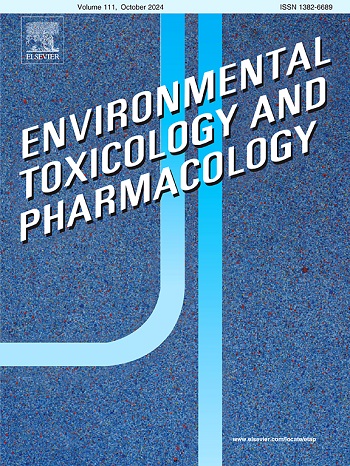星鲽暴露于六价铬对致死浓度 50%血液学参数和血浆成分的影响
IF 4.2
3区 环境科学与生态学
Q2 ENVIRONMENTAL SCIENCES
引用次数: 0
摘要
将星牙鲆(Platichthys stellatus,平均体重105±14g,平均体长20.2±0.7cm)暴露于浓度分别为0、5、10、20、40和80mg Cr6+/L的六价铬环境96小时。六价铬急性暴露96h后,星状螯虾的半致死浓度(LC50)为58.84mg Cr6+/L。血液学指标中,红细胞计数、血红蛋白、红细胞压积显著升高(P < 0.05)。由于暴露于水性六价铬,主要等离子体成分也发生了显著变化。血浆无机组分中钙含量显著升高,血浆有机组分中葡萄糖和胆固醇含量也显著升高(P < 0.05)。高水平水性六价铬暴露组血浆酶组分AST、ALT和ALP显著升高(P < 0.05)。本研究结果表明,急性暴露于水生六价铬会影响星状拟鱼的存活率、血液学特性和血浆成分。本文章由计算机程序翻译,如有差异,请以英文原文为准。
Effects on lethal concentration 50 % hematological parameters and plasma components of Starry flounder, Platichthys stellatus exposed to hexavalent chromium
Starry flounders (Platichthys stellatus, mean weight 105 ± 14 g, mean total length 20.2 ± 0.7 cm) were exposed to hexavalent chromium concentrations of 0, 5, 10, 20, 40, and 80 mg Cr6 +/L for 96 hours. The half-lethal concentration (LC50) of P. stellatus induced by acute exposure to waterborne hexavalent chromium for 96 hours was found to be 58.84 mg Cr6+/L. In hematological parameters, red blood cell counts (RBCs), hemoglobin and hematocrit were significantly increased (P < 0.05). Major plasma components also changed significantly due to exposure to waterborne hexavalent chromium. Calcium in plasma inorganic components significantly increased, and glucose and cholesterol in plasma organic components also showed significant increases (P < 0.05). Plasma enzyme components such as AST, ALT and ALP were significantly increased (P < 0.05) at high levels of waterborne hexavalent chromium exposure. The results of this study suggest that acute exposure to waterborne hexavalent chromium in P. stellatus affects survival rates, hematological properties and plasma components.
求助全文
通过发布文献求助,成功后即可免费获取论文全文。
去求助
来源期刊
CiteScore
7.00
自引率
4.70%
发文量
185
审稿时长
34 days
期刊介绍:
Environmental Toxicology and Pharmacology publishes the results of studies concerning toxic and pharmacological effects of (human and veterinary) drugs and of environmental contaminants in animals and man.
Areas of special interest are: molecular mechanisms of toxicity, biotransformation and toxicokinetics (including toxicokinetic modelling), molecular, biochemical and physiological mechanisms explaining differences in sensitivity between species and individuals, the characterisation of pathophysiological models and mechanisms involved in the development of effects and the identification of biological markers that can be used to study exposure and effects in man and animals.
In addition to full length papers, short communications, full-length reviews and mini-reviews, Environmental Toxicology and Pharmacology will publish in depth assessments of special problem areas. The latter publications may exceed the length of a full length paper three to fourfold. A basic requirement is that the assessments are made under the auspices of international groups of leading experts in the fields concerned. The information examined may either consist of data that were already published, or of new data that were obtained within the framework of collaborative research programmes. Provision is also made for the acceptance of minireviews on (classes of) compounds, toxicities or mechanisms, debating recent advances in rapidly developing fields that fall within the scope of the journal.

 求助内容:
求助内容: 应助结果提醒方式:
应助结果提醒方式:


